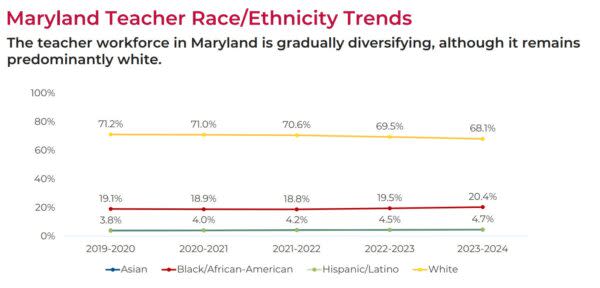Wright: There must be ‘a conscious effort’ to grow, diversify Maryland’s teacher workforce

Maryland Schools Superintendent Carey Wright speaks at a State Board of Education meeting May 21, 2024. Photo by William J. Ford.
Maryland State Schools Superintendent Carey Wright said Tuesday that school leaders must work harder to diversify and boost the state’s teacher workforce.
“It’s got to be a conscious effort,” Wright said during a break at the state Board of Education meeting in Baltimore. “Are we really going into our HBCUs? Are we recruiting? What do those techniques look like?”
Her comments came as the board was considering a recent state Department of Education report that showed the state has made little progress in recent years in diversifying its teacher workforce. The report said 68% of the state’s teachers in the current school year are white compared to 20% Black and about 5% Latino or Asian.
But Wright said another challenge facing school systems is hiring and retaining teachers in the state.
“We aren’t producing enough of those candidates in house, so we’ve got to be thinking about what else are we going to do,” she said.
A few ideas were highlighted as part of a teacher workforce report with various data that included teacher retention in all 24 school systems, those enrolled in state preparation programs and number of those who received National Board Certification.

Starting in two weeks, a work group will convene to assess recruiting and retaining a diverse teacher workforce. The task force will include representatives from the Maryland Higher Education Commission, the state’s historically Black colleges and universities, the College of Southern Maryland and at least seven school districts – Baltimore, Dorchester, Frederick, Kent, Montgomery and Prince George’s counties and Baltimore City.
“We have a very diverse group of stakeholders from all of these entities,” said Kelly Meadows, assistant state superintendent in the division of educator certification and program approval. “Our charge is to come together to [find] solutions and overcome the challenges of recruiting and retaining our high-quality workforce here in Maryland.”
Meadows said other solutions are to market the state’s revamped teacher-recruiting website, produce short YouTube videos to summarize the teaching profession and visit school districts to inform officials about various teacher pathways and certification opportunities.
The report also found that of the state’s 1,626 “accomplished” educators – those who have been designated as National Board Certified – 1,204, or 74%, were concentrated in four counties: Montgomery, Prince George’s, Anne Arundel and Howard.
The Blueprint for Maryland’s Future education reform plan called for salary increases for teachers with that national designation beginning in the 2021-22 school year. About 976 teachers enrolled in the program that year. When the salary increase was raised a year later to as much as $10,000 a year, more than 3,000 teachers applied, followed by another 3,800 in the current school year.
As of December, Meadows said every jurisdiction in the state has at least one teacher with that designation.
Of teachers with conditional certification – those who have a bachelor’s degrees but haven’t completed the requirements for a professional teacher’s license – more than half have been Black in the last five school years, the report said. In comparison, white teachers accounted for about 32% of those conditionally certified over the same period.
“Our conditional cert teachers better reflect the communities. That’s where many of the people come from,” said Joshua Michael, vice president of the board.
Last year, the legislature approved House Bill 1219 requiring that the department establish an educator recruitment, retention and diversity dashboard. Data from that dashboard will be publicly available by Jan. 1. Some of the data will include gender, race, new hires and attrition rate. Meadows said the dashboard will also highlight teacher interns.
“The key is to hopefully follow this individual into the school system, into employment and really publicize the diversity of our classrooms so that there is awareness around what we need in Maryland,” she said.
A gift
In other business, the board voted unanimously to approve the use of $350,000 to implement a science of reading program for an estimated 30,000 paraprofessionals, teachers, school literacy supervisors and school administrators across the state. The money will be used for meeting space, stipends and other administrative costs of the program, that focuses on teaching students based on phonics, comprehension and vocabulary.
Wright, who led the science of reading program while superintendent of public schools in Mississippi, announced the money is in conjunction with a four-year, $6.8 million grant from the nonprofit Ibis Group of Washington, D.C.
About $5.3 million will go to the State University of New York (SUNY) and to the AIM Institute for Learning and Research of Conshohocken, Pennsylvania, to provide online training for the science of reading program. The other $1.5 million for Johns Hopkins University and the department to research the impact of teacher efficacy, teacher background knowledge and literacy leadership development.
The training, which will be free for Maryland educators, will start July 1.
Tenette Smith, executive director of literacy programs and initiatives in the department, said training will take about 35 hours to complete. Smith worked with Wright in Mississippi on the science of reading program.
All of Maryland’s school systems must have the science of reading program implemented in the 2024-25 school year.
The post Wright: There must be ‘a conscious effort’ to grow, diversify Maryland’s teacher workforce appeared first on Maryland Matters.

